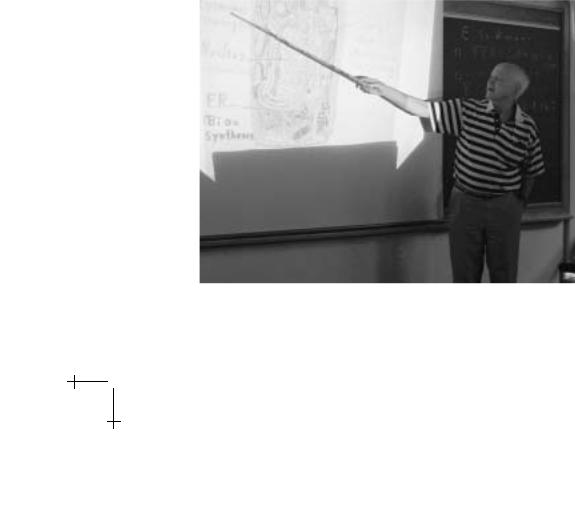
Physics of biomolecules and cells
.pdf
J. Prost: The Physics of Listeria Propulsion |
229 |
4.4 Growth with spherical symmetry
The arguments developed above allow us to write the gel thickness growth as:
de |
|
+ |
|
e2 |
− − |
|
e |
|
dt |
|
−e02 |
e2 |
|||||
|
= a |
kb0 exp |
|
|
kp0 exp |
|
|
|
(where we have omitted the k−b term for the sake of simplicity). The solution of this equation with initial condition e = 0, is a continuous monotonic function, with essentially two regimes:
–at short times the growth is predicted to be linear: ddet = a(k+b0 −k−p0), that is with obvious notations, e = νp0t. Such a relation is probably too naive since it ignores the problems of the nucleation of filaments and of their multiplication with Arp2/3, etc.
–at long times, the gel thickness is close to its steady state value e and the dynamical equation can be linearised as a function of δe = e − e . The solution is then:
|
|
|
|
|
1 |
|
− |
|
τ |
|
|
|
|
|||
|
δe(t) = δe(t |
|
) exp |
|
|
t − t1 |
; |
|
1 |
|
||||||
|
|
|
|
|
|
|
||||||||||
|
|
e a |
|
a |
|
|
− |
e2 |
|
2e |
|
|
||||
+ |
e02 |
|
e2 |
|
e02 |
e02 |
|
e2 |
||||||||
τ −1 = kb0 |
2 |
|
+ |
|
|
exp |
|
|
= |
|
|
+ |
|
νp. |
||
The thickness approaches its steady state value exponentially with a time constant growing linearly with the sphere radius r.
4.5 Symmetry breaking
In the following we keep the arguments as simple as possible, and deal only with the thin shell regime. A more elaborate version can be found in reference [29]. As understood first by Sekimoto the important point is that mechanical equilibrium requires that the total integrated tension across the gel thickness must be constant everywhere. If the gel thickness is smaller in some place than in others, since the integrated tension is the same, this means that the tensile stress must be larger. Now, since the de-polymerisation rate at the exterior surface depends exponentially on the tensile stress, this means that the de-polymerisation is faster where the gel is thinner, which amplifies the thinning process. This is a clear sign of instability, which we investigate in the following.
Assume that at some point the gel thickness has picked up a sinusoidal variation of the sort (Fig. 5):
e(t) = ei(t) + ε(t) cos(θ).

230 |
Physics of Bio-Molecules and Cells |
In which θ is the polar angle in spherical coordinates, ei and ε the isotropic and anisotropic parts of the gel thickness. We consider the system in the late time regime since in the earlier regime the stresses play essentially no role. Thus we can consider ei − e and ε as small quantities which we need to treat at first order only, for the discussion of stability. The tension being constant, it cannot depend on θ, and can only depend on ei and ε2, thus to lowest order:
T = B |
|
e2 |
|
|
|
|
and, σr = |
T |
= const. |
|||||
|
r + 0 ε |
2 |
r |
|||||||||||
|
|
|
i |
|
|
|
|
|
|
|
|
|
||
On the contrary: |
|
|
|
|
|
|
|
|
|
|
|
|
|
|
σθ = |
|
T |
= |
T |
1 |
− |
ε |
cos(θ) + 0 ε2 . |
||||||
|
|
|
||||||||||||
e(θ, t) |
ei |
ei |
||||||||||||
As announced the tensile stress is maximal where the thickness is minimal. If we extend the use of the dynamical equation to this non-homogeneous
case, we can write: |
|
|
|
|
|
|
|
|
|
|
|
|
|
|
|
|
|
|
|
|||
|
de(θ, t) |
= a |
kb0 exp |
|
e2 |
|
|
|
|
kp0 exp |
|
|
ei |
|
1 |
|
ε |
cos(θ) |
|
|||
|
|
|
i |
|
|
|
|
|
|
|
|
|
|
. |
||||||||
|
dt |
−e02 |
|
− |
|
|
|
|
− ei |
|||||||||||||
|
|
+ |
|
|
− |
e2 |
|
|
|
|||||||||||||
Which yields after linearisation: |
|
|
|
|
|
|
|
|
|
|
|
|
|
|
|
|||||||
|
|
|
|
|
|
|
dδei |
= − |
δei |
|
|
|
|
|
|
|||||||
|
|
|
|
|
|
|
|
dt |
|
|
τ |
|
|
|
|
|
|
|
|
|
||
|
|
|
|
|
|
|
|
|
dε |
= + |
ε |
· |
|
|
|
|
|
|
||||
|
|
|
|
|
|
|
|
|
dt |
|
τ0 |
|
|
|
|
|
|
|||||
As expected, we find that the isotropic part is stable and converges exponentially fast toward the steady state value e , and that the symmetry breaking part is always unstable and grows exponentially fast with a time
scale τ0 |
= τ (1 + 2 e2 |
2e ) = |
e2 |
. Note that τ0 grows linearly with the bead |
|
e |
0 |
νp |
|
radius, just like τ , and is of the same order of magnitude. |
||||
Now we know that symmetry-breaking fluctuations are amplified, but where do they come from? Could thermal fluctuations be su cient?
The typical fluctuation amplitude can be expressed as:
εb = Br2 |
1 |
|
· |
||
|
kT e |
2 |
For a 100 nm bead such as used in [8], the corresponding amplitude is in the nanometer range. It might be su cient to trigger the instability because of its exponential amplification. However, other factors such as enzyme

J. Prost: The Physics of Listeria Propulsion |
231 |
heterogeneous distribution or deviation from pure spherical shape may be more important. For instance if there is a total number N of enzymes at the
1
bead surface, there will always be an imbalance of the order of N 2 between the two sides of the bead. The integrated tension T is still a constant and so is the normal stress σr at the bead surface. However the force acting on filaments now depends on position through the enzyme density dependence. With l2(θ) = li2 + 2la.li cos(θ), li, la being the isotropic an anisotropic parts of the average distance between nucleation enzymes, one obtains a force per filament, l2σr, which also depends on angle and the equation for the anisotropic part of the gel thickness becomes:
|
|
|
dε |
= |
ε |
+ νb. |
|
|
|
|
|
||
In which νb = li νp = |
|
|
dt |
τ0 |
||
√N νp; νp is the polymerisation velocity as defined |
||||||
2la |
2 |
|
|
|
|
|
in the first part of this article. The solution reads:
ε(t) = νbτ0 exp |
t |
− 1 . |
τ0 |
In order to assess, which of thermal fluctuations or enzyme heterogeneity, is the leading term in the symmetry breaking source, one should then compare νbτ0, and εb. Their bead radius dependence is such that at r large enough the enzyme disorder should always win. Plugging reasonable orders of magnitudes, suggests that even for a few nanometers size bead the enzyme disorder is already more important.
An other symmetry-breaking source is the lack of sphericity of the beads. Arguments, very similar to the one we have used for enzymes heterogeneity, can be made. One has essentially to replace llai , by rrai in which the subscripts refer to the beads radius of curvature variation, with obvious meaning. It is di cult to put numbers on this term, since it depends on the preparation chemistry of the beads. It seems that beads smaller than a micron, have excellent sphericity, controlled by surface tension. In that range one expects enzyme heterogeneity to provide the main symmetry breaking term. It seems more di cult to obtain beads larger than a few microns, in which case spherical aberrations might provide the main symmetry breaking term. It would be interesting to design carefully controlled experiment, for checking quantitatively these predictions. Clever microscopic models have been imagined in order to obtain symmetry-breaking conditions [17,30]. However they do not take into account the very nature of the actin gel.
4.6 Limitations of the approach and possible improvements
In the discussion developed above, we have kept only diagonal stresses. However as soon as the gel thickness is inhomogeneous, some of the elastic

232 |
Physics of Bio-Molecules and Cells |
energy is released by shear, and a complete analysis should contain the corresponding terms. One can show however that the exposed results are not changed in any significant way [29]. Furthermore, whenever the anisotropy changes with time, the gel redistribution causes friction at the bead/gel interface, a phenomenon that is not included in the present analysis. It is in fact possible to show that it does not modify the structure of the equations but simply renormalizes the onset time τ0 of the anisotropy.
Indeed, under such circumstances, the tension has an angular dependent part, which must be proportional to the friction coe cient, the velocity of the gel relative to the bead and have the right dimensions:
dε
T (θ) = Ti + κξr d cos(θ). t
Where κ is a dimensionless number and ξ is the bead/gel friction coe cient already discussed. The equations are formally unchanged and only the onset time of the modulation is modified to a new value:
τ0 = τ0 + r2 e2 + e−1 .
νi e20
The main conclusions are similar to the one obtained before, for instance the symmetry breaking onset time is again proportional to the sphere radius, since e0, e2 and e are. This expectation is indeed born out by experiment [31]. Furthermore if the friction is very high the spherical steady state can be reached much before symmetry is actually broken. This will in particular happen if the gel is dense, expectation also born out by experiment.
There are several other implicit simplifications in the above presentation: we have considered only one elastic modulus, without specifying whether it corresponds to compression or shear or a combination of them. A proper description is possible by the use of a covariant description of the gel [29]. Actually, the very geometry of the polymerisation/cross-linking process implies that the gel should be anisotropic as well, but keeping this feature adds in complexity without bringing further understanding to the question.
A more important limitation comes from the hidden assumption that the gel density is constant throughout the gel and that all de-polymerisation is located at its external surface. In fact it is known that the gel density decreases exponentially in a Listeria comet, over length scales comparable to the comet total length, i.e. several tens of microns [13]. One could be tempted to argue that this length scale is much larger than the one we discuss here and forget about this slow bulk de-polymerisation. It would, however, be a wrong argument, since the de-polymerisation mechanism is certainly stress dependent. In fact, the dynamical equation for the gel

J. Prost: The Physics of Listeria Propulsion |
233 |
density ρ should read:
∂ρ + ν · ρ = S − kdρ. ∂t
Where, ν is the gel velocity relative to the bead or the bacterium, S is the gel density source localised at or close to the surface, and kd is the de-polymerisation probability per monomer connected to the gel, per unit time. In general, one expects stress dependence similar to the one already
described, that is kd = k0 exp( σtφ2a3 ), in which φ2 = ρ−1a−1 is the average |
||
d |
kT |
|
area spanned by a filament, and a3 |
a model dependent length. Far from |
|
the surface, in an essentially unstressed comet tail, one does obtain an
exponential decrease of the density |
over a length L = |
ν |
. Knowing ν |
|
k0 |
||||
and the comet length, one deduces |
|
|
d |
|
k0 |
easily. The physical mechanism, |
|||
|
d |
|
|
|
behind this de-polymerisation is not obvious: it could be that actin filaments
can spontaneously break anywhere, or that reticulation points stabilise the structure and provide the rate limiting step in the de-polymerisation, or that there is a one to one mapping of the pointed end density on the connected monomer density. In all cases a constant average number of monomers should leave the gel for each event. Note that a de-polymerisation from the pointed ends of the filaments cannot in general be represented by such a mathematical structure. For instance if the filaments were parallel on average, all starting from the surface at the barbed end, and with a length distribution, the term would read −k−p ap · ρ, in which p is the unit vector
in the filaments direction. Indeed, under such circumstances ap · ρ is a measure of the printed and density.
Because of the exponential dependence of the de-polymerisation coefficient on stress, the length over which the density significantly decreases, may become very short in the presence of such a stress and this mechanism could provide an alternative interpretation of the steady state in spherical symmetry. Under such circumstances, the density decrease occurs essen-
tially over a length such that σt = |
kT |
, or with the scaling laws derived |
φ2a3 |
in spherical geometry e = BakT ρ3 r. The sharpness of the density decrease is controlled by the ρ dependence of B. In all reasonable cases, it is quite pronounced. For instance, if B is proportional to ρ, which is the case whenever the cross-link angular elasticity determines the elastic modulus, then
ρ = ρ0 exp( αL (1 −exp( |
r0 |
))). In this equation, r0, ρ0 denote the radius |
|
|
r0 |
α(r−r0) |
|
and density at the bead surface, and α a dimensionless number of order ten. There is a sharp cut o , for r − r0 = rα0 . Further considering that below a threshold density, the gel integrity is totally lost, it is clear that any thickness measurement will give a value very close to rα0 , essentially equivalent to the one derived in Section 4. The drawback of this type of presentation is the added complexity. Its merit is the connection of the comet slow density

234 |
Physics of Bio-Molecules and Cells |
decrease with the fast one under stress. The same type of result holds for other ρ dependences of B, such as the one used in Section 2.
An observation, which is not accounted for by the present analysis, is the strong density increase of the comet in the saltatory mutant. Simulations, taking into account the detailed chemistry of the polymerisation process, but ignoring the role of the polymerisation enzyme, show a strong density dependence on external stress [16]. A simple phenomenological way of taking this e ect into account consists in writing the gel density source s:
S = νρ− exp |
ντ |
δs. |
|
|
|
ls |
|
In which δs is the delta function at the surface. ρ− = l21a , is determined by the enzyme density, the exponential factor expresses the exponential growth due to Arp 2/3, ls the length over which the branching phenomenon can occur and τ a typical capping time. The gel density ρ+, just outside the proximal domain, reads: ρ+ = ρ− exp( ντls ). The expression of the growth velocity ν is model dependent. If one assumes that a fraction of order unity of all filaments contributes to the stress, then the natural generalisation of
the polymerisation law under stress reads: ν = |
νp0 exp(− |
σnρ−1a0 |
). Solving |
|||||||||
+ |
||||||||||||
kT a |
||||||||||||
for this set of equations reproduces fairly well the results of the simulation. |
||||||||||||
Indeed, in the large force, slow velocity limit, one finds: ν = |
|
|
|
, |
||||||||
τ Ln( kT ρ− ) |
||||||||||||
|
|
|
|
|
|
|
|
|
lsσn |
|||
|
|
νp |
, in which we have assumed a |
0 |
= |
|
|
|
|
|
|
|
and ρ = |
|
a for simplicity. In this |
||||||||||
σn |
|
|
||||||||||
0 |
|
|
|
|||||||||
|
kT Ln( |
|
) |
|
|
|
|
|
|
|
|
|
|
ν |
|
|
|
|
|
|
|
|
|
||
regime, the velocity is essentially independent of stress and determined by the branching and capping processes. Conversely, the density is practically proportional to the stress. Both features show up clearly in the simulation. For “large” velocities a more conventional regime in which ρ+ = ρ−, and ν = νp0 exp(−kTσρn− ), may exist. Such a formulation should be exploited
further.
5 Conclusion
In these lectures we have shown that if one wants to understand the physics of the propulsion mechanism of the bacterium Listeria, one must analyse the mesoscopic stress distribution in the actin gel, and the solid on solid friction that the gel exerts on the bacterium surface. Keeping in mind, only the polymerisation process misses so to speak half of the problem. In particular, recognizing the importance of the non-linear friction allows us to understand the saltatory mutant as being a system working in a “stick-slip” regime familiar in solid friction. In general the system gets into the saltatory regime at a well defined threshold called a Hopf bifurcation. In its vicinity measurable quantities such as the velocity and comet density modulations

J. Prost: The Physics of Listeria Propulsion |
235 |
are sinuo¨ıdal functions (of time and space respectively). Away from the bifurcation variations are more abrupt like in Figure 2. It is important to understand that the role of mutation is simply to drive the system in a region of phase space where the behaviour is saltatory, but that many other external perturbations could have the same result without changing the genome. This point is well illustrated in bio-mimetic experiments, where a simple bead diameter change drives the behaviour from regular to saltatory. This example shows that the relation between genotype and phenotype will not be easy to unravel. One will need to fully understand all the complex dynamical diagrams governing biological systems, before being able to fully exploit the formidable genetic data that we are getting now.
It is important to stress that the mesoscopic approach is not antagonistic to microscopic ones, but rather complementary. Microscopic theories can be used as input for writing boundary conditions in mesoscopic theories. They should not only focus on the polymerisation process, but on friction and de-polymerisation as well. An other message is that, even if the Listeria propulsion mechanism can be, in some way, representative of the biochemistry involved in more complex Eukaryotic cells, the physics of it will be very di erent for two simple reasons. Indeed, the stress distribution will be very di erent because the gel is now produced in the inside of an object topologically spherical, and second because the tangential friction is very di erent since on a fluid membrane. Yet, what we learn here will be very useful for understanding cell motility. At last, what I find most rewarding, is the potential importance of the bio-mimetic approach for medical applications [32, 33].
The ideas developed here result from many discussions with F. J¨ulicher, K. Sekimoto and C. Sykes. It is a pleasure for me to express my warm thanks. I further thank C. Sykes for her help with the reference list. I am also grateful to M.F. Carlier and D. Pantaloni for introducing me to the biochemistry of actin polymerisation.
References
[1]L.G. Tilney and D.A. Portnoy, J. Biol. Chem. 109 (1989) 1597-1608.
[2]F.S. Southwick and D.L. Purich, New Engl. J. Med. 334 (1996) 770-776.
[3]D. Bray, Cell Movements (New York: Garland, 2001).
[4]I. Lasa, E. Gouin, M. Goethals, K. Vancompernolle, V. David, J. Vandekerkhove and P. Cossart, EMBO J. 16 (1997) 1531-1540.
[5]T.M. Svitkina and G.G. Borisy, J. Cell Biol. 145 (1999) 1009-1026.
[6]L. Blanchoin, K.J. Amann, H.N. Higgs, J.B. Marchand, D.A. Kaiser and T.D. Pollard, Nature 404 (2000) 1007-1011.
[7]T.P. Loisel, R. Boujemaa, D. Pantaloni and M.-F.Carlier, Nature 401 (1999) 613-616.
[8]L.A. Cameron, M.J. Footer, A. van Oudenaarden and J.A. Theriot, Proc. Natl. Sci. USA 96 (1999) 4908-4913.

236 |
Physics of Bio-Molecules and Cells |
[9]V. Noireaux, et al., Biophys. J. 78 (2000) 1643-1654.
[10]J.A. Theriot, T.J. Mitchison, L.G. Tilney and D.A. Portnoy, Nature 357 (1992) 257-260.
[11]C. Knocks, J.B. Marchand, E. Gouin, H. d’Hauteville, P.J. Sansonetti, M.F. Carlier and M.F. Cossart, Mol. Microbiol. 18 (1995) 413.
[12]F. Gerbal, et al., Pramana 53 (1999) 155-170.
[13]F. Gerbal, V. Laurent, A. Ott, M.-F. Carlier, P. Chaikin and J. Prost, Eur. Biophys J. 29 (2000) 134-140.
[14]J.L. McGrath, N.J. Eungdamrong, C.I. Fischer, F. Peng, L. Mahadevan, T.J. Mitchison and S.C. Kuo, Science (2002).
[15]A. Mogilner and G. Oster, Biophys. J. 71 (1996) 3030-3045.
[16]A.E. Carlson, Biophys. J. 81 (2001) 1907-1923.
[17]A. Mogilner, S. Kuo and G. Oster (preprint).
[18]A. Mogilner and L. Edelstein–Keshet (preprint).
[19]E. Gouin, H. Gantelet, C. Egile, I. Lasa, H. Ohayon, V. Villiers, P. Gounon, P.J. Sansonetti and P. Cossart, Cell Sci. 112 (1999) 1697-1708.
[20]C.J. Merrifield, et al., Nat. Cell Biol. 1 (1999) 72-74.
[21]J. Taunton, et al. J. Cell Biol. 148 (2000) 519-530.
[22]K. Tawadac and K. Sekimoto, J. Theor. Biol. 150 (1991) 193-200.
[23]F. Gerbal, P. Chaikin, Y. Rabin and J. Prost, Biophys. J. 79 (2000) 2259-2275.
[24]F. Gerbal, Ph.D. Thesis (Universit Paris VII, 1999).
[25]D. Yarar, W. To, A. Abo and M.D. Welch, Curr. Biol. 9 (1999) 555-558.
[26]J. Fradelizi, et al., Nat. Cell Biol. 3 (2001) 699-707.
[27]V. Noireaux, Ph.D. Thesis (Universit Paris XI, 2000).
[28]J. Plastino and C. Sykes (private communication).
[29]K. Sekimoto and F. Julicher and J. Prost (in preparation).
[30]A. Van Oudenaarden and J.A. Theriot, Nature Cell Biol. 1 (1999) 493-499.
[31]A. Bernheim–Groswasser, S. Wiesner, R. Golsteyn, M.-F. Carlier and C. Sykes, Nature (2002) (accepted).
[32]E. Friederich, R.M. Golsteyn, D. Louvard, V. Noireaux, J. Prost and C. Sykes, Institut Curie/CNRS, patent No. PCT/FR00/03569 (2000).
[33]J. Fradelizi, E. Friederich, R.M. Golsteyn, D. Louvard, V. Noireaux and C. Sykes, Institut Curie/CNRS patent No. PCT/FR01/00843 (2001).

COURSE 6
PHYSICS OF COMPOSITE CELL MEMBRANE AND ACTIN BASED CYTOSKELETON
E. SACKMANN
Physics Department, Lehrstuhl f¨ur
Biophysik – E22, Technische
Universit¨at M¨unchen, Munich,
Germany

Contents
1 Architecture of composite cell membranes |
239 |
1.1The lipid/protein bilayer is a multicomponent smectic phase
with mosaic like architecture . . . . . . . . . . . . . . . . . . . . . |
239 |
1.2The spectrin/actin cytoskeleton as hyperelastic cell stabilizer . . . 242
1.3 The actin cortex: Architecture and function . . . . . . . . . . . . . 245
2 Physics of the actin based cytoskeleton |
249 |
|
2.1 |
Actin is a living semiflexible polymer . . . . . . . . . . . . . . . . . |
249 |
2.2 |
Actin network as viscoelastic body . . . . . . . . . . . . . . . . . . |
253 |
2.3Correlation between macroscopic viscoelasticity and molecular
motional processes . . . . . . . . . . . . . . . . . . . . . . . . . . . |
258 |
3 Heterogeneous actin gels in cells and biological function |
260 |
3.1 Manipulation of actin gels . . . . . . . . . . . . . . . . . . . . . . . |
260 |
3.2Control of organization and function of actin cortex by cell signalling265
4 |
Micromechanics and microrheometry of cells |
267 |
5 |
Activation of endothelial cells: On the possibility of formation of stress |
|
|
fibers as phase transition of actin-network triggered by cell signalling |
|
|
pathways |
271 |
6 |
On cells as adaptive viscoplastic bodies |
274 |
7 |
Controll of cellular protrusions controlled by actin/myosin cortex |
278 |
